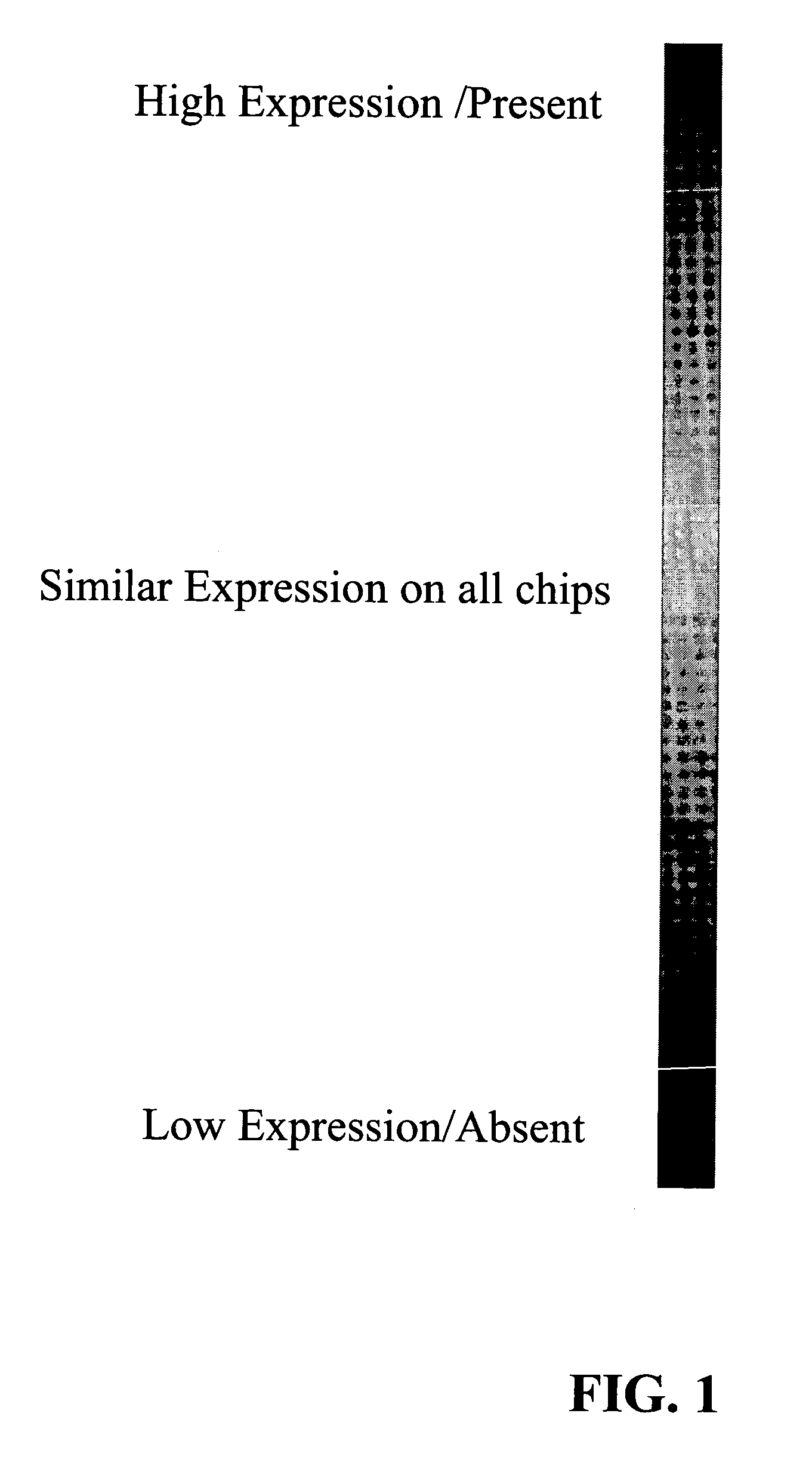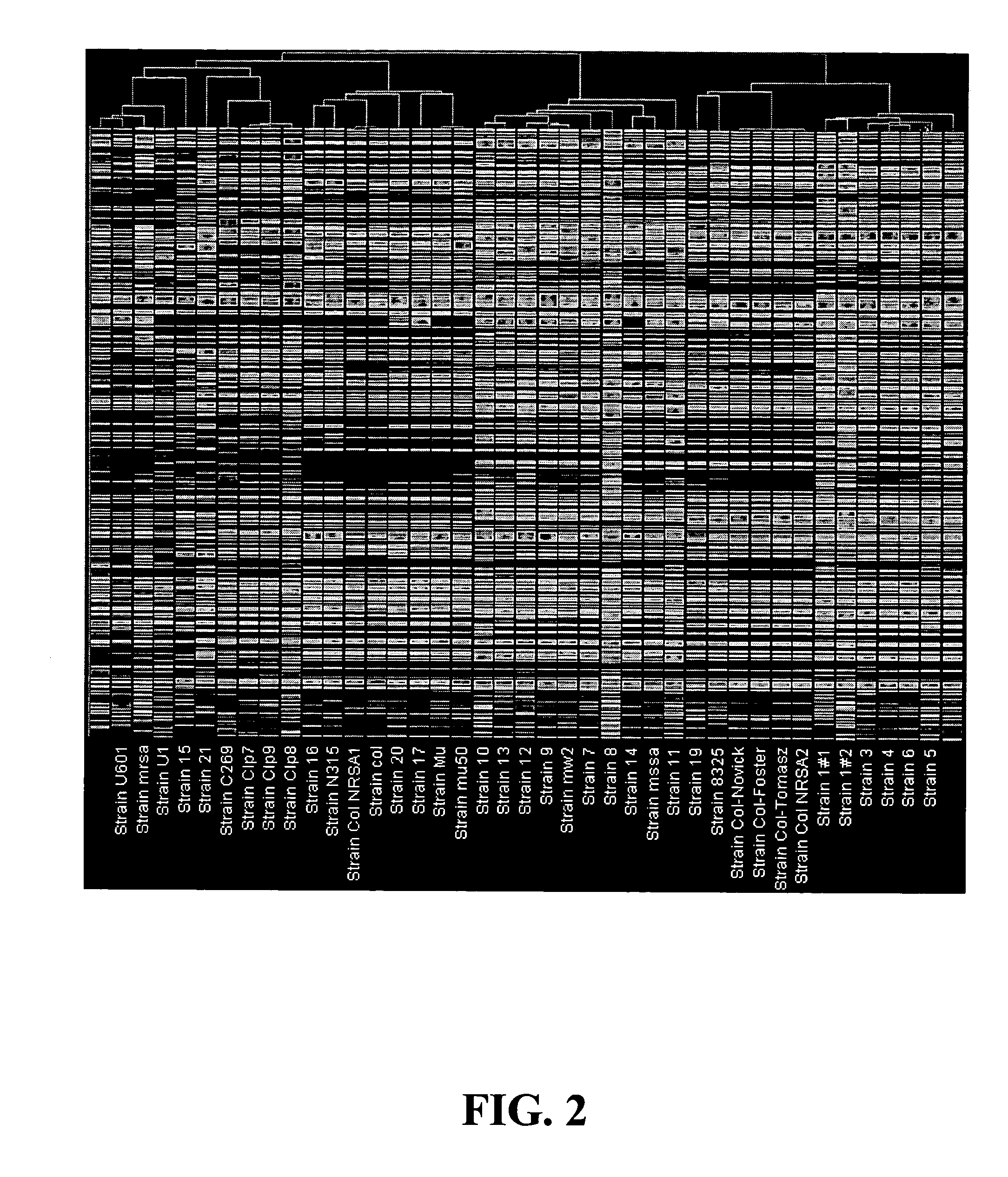Nucleic acid arrays for detecting multiple strains of a non-viral species
- Summary
- Abstract
- Description
- Claims
- Application Information
AI Technical Summary
Benefits of technology
Problems solved by technology
Method used
Image
Examples
example 1
Nucleic Acid Array
[0105] The tiling sequences depicted in SEQ ID NOs: 7,704 were submitted to Affymetrix for custom array design. Affymetrix selected probes for each tiling sequence using its probe-picking algorithm. Probes with 25 non-ambiguous bases were selected. A maximal set of 24-34 probes were selected for each submitted ORF sequence, and a maximal set of 12-15 probes were chosen for each submitted intergenic sequence. The final set of selected probes is depicted in SEQ ID NOs: 82,374. Table G shows the header for each of these probes. These probes are perfect match probes. The perfect mismatch probe for each perfect match probe was also prepared. The perfect mismatch probe is identical to the perfect match probe except at position 13 where a single-base substitution is made. The substitutions are A to T, T to A, G to C, or C to G. The final custom nucleic acid array includes both the perfect match probes and the perfect mismatch probes. In addition, the custom array contain...
example 2
Analysis of the Accuracy of the Nucleic Acid Array of Example 1
[0111] An analysis was conducted to confirm the performance of the nucleic acid array of Example 1 with respect to seven sequenced Staphylococcus aureus genomes, i.e., COL, N315, Mu50, EMRSA-16, MSSA-476, 8325, and MW2. Each tiling sequence in Table C was derived from the transcript(s) or intergenic sequence(s) of one or more Staphylococcus aureus strains. As used herein, if all of the oligonucleotide probes for a tiling sequence are present in the genome of a Staphylococcus aureus strain, then the tiling sequence is theoretically predicted to be “present” in the genome. The theoretical predictions were compared to the actual results of DNA hybridization experiments. Table 5 compares the results of the theoretical predictions for the seven sequenced Staphylococcus aureus strains to the results of actual hybridization experiments using the nucleic acid array of Example 1.
TABLE 5 Comparison of Theoretical and Actual Cal...
example 3
Sample Preparation for Monitoring Gene Expression
[0115] Total Staphylococcus aureus RNA is isolated from a control condition or a test condition. Under the test condition, bacterial cells have been either differentially treated or have a divergent genotype. cDNA is synthesized from total RNA of the control or test sample as follows. 10 μg total RNA is incubated at 70° C. with 25 ng / μl random hexamer primers for 10 min followed by 25° C. for 10 min. Mixtures are then chilled on ice. Next, 1×cDNA buffer (Invitrogen), 10 mM DTT, 0.5 mM dNTP, 0.5 U / μl SUPERase-In (Ambion), and 25U / μl SuperScript II (Invitrogen) are added. For cDNA synthesis, mixtures are incubated at 25° C. for 10 min, then 370C for 60 min, and finally 42° C. for 60 min. Reactions are terminated by incubating at 70° C. for 10 min and are chilled on ice. RNA is then chemically digested by adding 1N NaOH and incubation at 65° C. for 30 min. Digestion is terminated by the addition of 1N HCl. cDNA products are purified usi...
PUM
| Property | Measurement | Unit |
|---|---|---|
| Strain point | aaaaa | aaaaa |
| Antimicrobial resistance | aaaaa | aaaaa |
Abstract
Description
Claims
Application Information
 Login to View More
Login to View More - R&D
- Intellectual Property
- Life Sciences
- Materials
- Tech Scout
- Unparalleled Data Quality
- Higher Quality Content
- 60% Fewer Hallucinations
Browse by: Latest US Patents, China's latest patents, Technical Efficacy Thesaurus, Application Domain, Technology Topic, Popular Technical Reports.
© 2025 PatSnap. All rights reserved.Legal|Privacy policy|Modern Slavery Act Transparency Statement|Sitemap|About US| Contact US: help@patsnap.com



